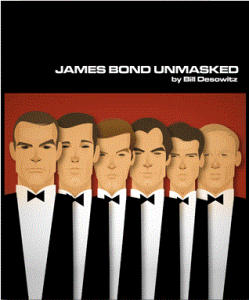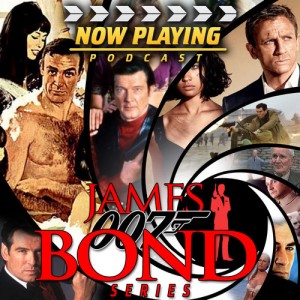By Devin Zydel on 2009-06-10

Thrilling Cities US Signet Paperback
Following up our examination of The Diamond Smugglers, Ian Fleming’s investigation into the diamond smuggling business, CommanderBond.net now moves on to the author’s 1963 collection of travel memoirs, Thrilling Cities.
The book is a collection of articles originally written for the London Sunday Times examining 13 cities throughout the world based on two trips Fleming took between 1959 and 1960. As Fleming states in the opening of the book, the idea originated in October 1959 when Sunday Times features and literary editor Leonard Russell suggested that he should make a ’round trip of the most exciting cities in the world and describe them in beautiful, beautiful prose.’
On 2 November, Fleming set off for a 30-day journey to visit Hong Kong, Macau, Tokyo, Honolulu, Los Angeles, Las Vegas, Chicago and New York. The series of articles was a success for the Sunday Times and in the spring of 1960, they convinced Fleming to head off once more, this time for a tour of the following European cities: Hamburg, Berlin, Vienna, Geneva, Naples and lastly Monte Carlo.
Finally in 1963, the two sets of articles were combined together and the result was Thrilling Cities: a would-be ordinary travel book turned extraordinary and well worth picking up for any fan of Fleming or James Bond.

Ian Fleming
Round the world with Ian Fleming – even on paper the prospect is enticing. Hong Kong, Macao, Tokyo, Honolulu, Los Angeles, and Las Vegas, Chicago, New York, Hamburg, Berlin, Vienna, Geneva, Naples, Monte Carlo – these are his thrilling cities. He writes about them brilliantly, impressionistically, as no one else would or could, ostensibly for our entertainment yet not without giving us the benefit of some expert observation.
All my life, he says, I have been interested in adventure and, abroad, I have enjoyed the frisson of leaving the wide, well-lit streets and venturing up back alleys in towns. It was perhaps this habit that turned me into a writer of thrillers, and, by the time I had made the two journeys that produced these essays, I had certainly got into the way of looking at people and places and things through a thriller-writer’s eye.
It is not a habit commonly shared with more ordinary or leisurely travellers. Their interests have been studied in supplements of Incidental Intelligence to each chapter. Idiosyncratic information is therefore included in a most original and exciting travel book.
UK Jonathan Cape First Edition Hardback

The 1959 Journey
- Hong Kong
- Macau
- Tokyo
- Honolulu
- Los Angeles and Las Vegas
- Chicago
- New York
The 1960 Journey
- Hamburg
- Berlin
- Vienna
- Geneva
- Naples
- Monte Carlo
Trivia & Notes
Thrilling Cities is one of three non-Bond published works by author Ian Fleming. The other two are The Diamond Smugglers and the popular children’s tale Chitty Chitty Bang Bang.
As Fleming mentions in the Author’s Note to the book, Thrilling Cities contains the complete, unedited versions of his articles.
Fleming’s visits to Los Angeles and Las Vegas are combined into a single article in the book.
In each article, Fleming includes a section entitled ‘Incidential Intelligence’ at the end which makes special note of hotels, restaurants and night-life locales worth visiting.
Thrilling Cities was first published in the UK by Jonathan Cape in 1963 and in the US by New American Library in 1964 (both regular publishers of Fleming’s James Bond novels). These releases coincided with the debut publications of On Her Majesty’s Secret Service and You Only Live Twice.

Thrilling Cities US New American Library Hardback
The UK Reprint Society Book Club edition of Thrilling Cities was a special edition limited to World Books members.
Pan Books split Thrilling Cities into two parts for the first UK paperback printing (the 1959 journey in part one and the 1960 journey in part two).
The UK editions of Thrilling Cities contain numerous photographs, while the US editions instead have illustrations by Milton Glaser that preceed each article.
The US Aeonian Press hardback, published in 1976, is particularly difficult for collectors to obtain as only 150 copies were printed.
In March 2008, it was announced that The Diamond Smugglers and Thrilling Cities, both long out of print, would be published in all-new hardback editions to mark the centenary of author Ian Fleming. Both titles are slated to be released in 2009. The Diamond Smugglers will be introduced by Fergus Fleming and Thrilling Cities by Jan Morris.
Release Timeline
- 1963: 1st British Jonathan Cape Hardback Edition
- 1964: 1st American New American Library Hardback Edition
- 1964: 1st British Pan Paperback Edition (Part 1)
- 1964: 1st British Pan Paperback Edition (Part 2)
- 1964: 1st British Reprint Society Book Club Hardback Edition
- 1964: 1st American New American Library Book Club Hardback Edition
- 1965: 1st American Signet Paperback Edition
- 19??: 1st American Dutton Hardback Edition
- 1976: 1st American Aeonian Press Hardback Edition
- 1987: 1st American Amereon Press Hardback Edition
- 2009: 1st British Penguin Books Hardback Edition
007 in New York

Thrilling Cities UK Jonathan Cape Hardback
As Ian Fleming makes quite clear in his article examining New York, it was the city he clearly enjoyed the least on his worldwide tour. Editors of the US edition of Thrilling Cities picked up on this and asked Fleming to provide some sort of additional material to counterpoint the author’s apparent distaste for the city. Fleming obliged by including the (short!) James Bond short story 007 in New York:
‘By way of a postscript I might say I am well aware these grim feelings I’ve expressed for New York may shock or depress some of my readers. In fact, I would be disappointed if this were not the case. In deference to these readers, I here submit the record of another visitor to the city, a friend of mine with the dull name of James Bond, whose tastes and responses are not always my own and whose recent minor adventure in New York (his profession is a rather odd one) may prove more cheerful in the reading.’
Ian Fleming
The 007 in New York short story was only included in US editions of Thrilling Cities and for several decades remained the only place for literary Bond fans to turn to read it (although the story was originally published in the The New York Herald Tribune in 1963). It finally debuted in the UK in 1999 in a magazine supplement to the Sunday Times. Following this, it was added as the fourth short story to the Octopussy and The Living Daylights collection, which was first published in the UK by Penguin Books in 2002 and in the US in 2004. It remains in this collection in all reprints and new publications since then.
For complete details on 007 in New York, including the recipe for Scrambled Eggs “James Bond”, visit this CommanderBond.net article.
‘It’s almost as fun as 007 battling SMERSH for the safety of Fort Knox. Other travel tomes may list beaches and shopping centers but Fleming concentrats on the more interesting matters: bawdy houses, GIRLS, gambling, GIRLS, whiskey, GIRLS, dirty entertainment—with and without GIRLS. He provides a sort of Playboy guide to…the cities where James Bond would go for recreation.’
Denver Post
Your Own Opinion On Thrilling Cities
Want to share your thoughts and opinion on Thrilling Cities? Feel free to discuss this little-known non-Bond book by Ian Fleming by visiting this thread on the CommanderBond.net Forums.
Keep watching the CommanderBond.net main page—and our Twitter feed—for the most up-to-date literary James Bond coverage on the web.

 Having people everywhere is a lot of fun, especially when it entails getting one’s hands on stuff ordinary mortals will only be able to read on Monday. Just ask Jim, who was tasked with reviewing Mark O’Connell’s ‘Catching Bullets’ and evidently encountered a fully operative time machine…
Having people everywhere is a lot of fun, especially when it entails getting one’s hands on stuff ordinary mortals will only be able to read on Monday. Just ask Jim, who was tasked with reviewing Mark O’Connell’s ‘Catching Bullets’ and evidently encountered a fully operative time machine…


















 adventures have all been celebrated, debated and dissected by critics and Bond fans all over the globe. 52 years later, one wonders, what can Henry Chancellor’s
adventures have all been celebrated, debated and dissected by critics and Bond fans all over the globe. 52 years later, one wonders, what can Henry Chancellor’s 
